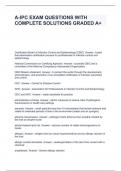Resume
Summary IRM Principles of Corporate Finance ()
- Cours
- Établissement
- Book
Deze samenvatting van het IRM boek Principles of Corporate Finance bevat alle hoofdstukken die je moet kennen voor je tentamen (H7, 8, 20, 21, 26). Daarnaast bevat deze samenvatting duidelijke voorbeelden van berekeningen.
[Montrer plus]













